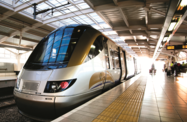The launch of the Gautrain – South Africa’s new high-speed train service – may be grabbing headlines, but the $3.8bn project could soon be overshadowed by even larger developments aimed at upgrading and expanding the country’s less prestigious but vital freight network.
The high-speed train entered service on June 8 last year, just ahead of the 2010 World Cup, providing a limited service between Johannesburg and OR Tambo International Airport. More recently, an extended line from Johannesburg to Pretoria opened, having been cleared for operations at the beginning of August. The Gautrain will likely ease congestion on the roads and cut travel time for more than 150,000 train commuters daily.
Meanwhile, insufficient freight railway capacity may be slowing economic activity in the country. Richards Bay Coal Terminal, one of the largest coal export terminals in the world, has been putting pressure on Transnet, the state-owned logistics group that operates the country’s freight rail services, to expand capacity of the rail links that serve the terminal, according to local media reports. Mining companies have also complained that they have not been able to meet rising demand for coal due to capacity constraints on the network that connects Witbank, a major mining area, to the terminal at Richards Bay.
Although successive governments have vowed to step up investments in the national rail grid, most of these plans have yet to be implemented. In a sign that this trend may be changing, however, at the end of July, the government announced that a new body would be established to coordinate the state’s $139bn public investment programme. The new organisation, dubbed the “Infrastructure Commission”, is to be chaired by President Jacob Zuma and would be tasked with fast-tracking stalled or delayed developments, with transport projects given priority on the agenda.
Unveiled after a three-day cabinet meeting of ministers and other top-level government officials that was held on July 26-28, the minister in the presidency, Collins Chabane, said that the new commission would ensure the systematic selection, planning and monitoring of large projects.
“This intervention will systematically improve the state agencies to deliver infrastructure and help connect the work of all spheres of government,” he told the press following the official meeting. “The revitalisation of rail infrastructure for freight and passenger was also highlighted. ” Apart from the emphasis on rail services, Chabane also said that the infrastructure programme would be positioned at the centre of the government’s campaign to boost the economy.
Transnet also has a number of modernisation projects in the works. In late May, public enterprises minister, Malusi Gigaba, announced that large numbers of diesel and electric locomotives would be added to the parastatal’s existing fleet, with the objective of reducing the average age of its locomotives, which currently stands at about 33 years. According to Gigaba, the 15-year-long acquisitions programme is essential to increasing rail’s share of the freight market.
The state-owned logistics group also plans to buy new rolling stock and strengthen the signalling network. All of this will be expensive, and while the government will invest in some infrastructure developments for the sector, the parastatal also has large-scale outlays to meet. Indeed, in June, Transnet announced that it was planning to borrow $3.85bn over the next five years to fund its capital programme and pay back some of its existing loans.
Quite apart from the cargo haulage services, the rest of the rail network is also in line for an upgrade. Passenger services will be getting a major boost, Minister of Transport Sibusiso Ndebele announced in April. Over the next three years, the government will allocate R30.2bn ($4.14bn) to the Passenger Rail Agency of South Africa (PRASA), the state-owned operator of the passenger rail system, for the purpose of upgrading the signalling system and rolling stock. In the longer term, PRASA plans to invest R97bn ($14bn) in new rail rolling stock over an 18-year period.
Meanwhile, in late August the Department of Transport proposed to split Transnet’s rail operations into a separate firm that could see the company’s infrastructure assets housed in a state-owned rail utility, which would manage them on behalf of the government. Parts of the rail network would be open to the private sector, a draft of the proposal stated.
The prioritisation of the rail system is timely, although it will be years before the full impact of the government’s investments are felt. However, by investing in rail, South Africa hopes to ensure that it has sufficient capacity for moving both freight and people.

